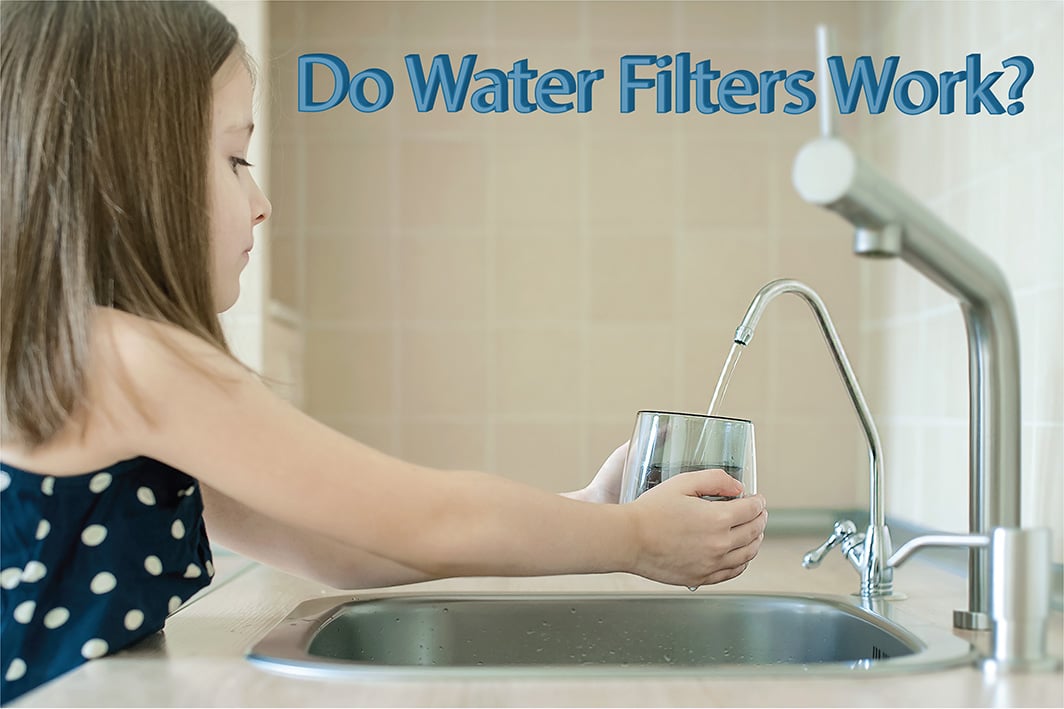
One of the first questions new clients ask before making a purchase decision about a water filtration system, is whether or not they work, and then usually how they work. It's understandable, since filtering water usually means removing tiny contaminant particles that don't change its appearance. When you see a survival filter turn brackish water into pure, drinkable water, it's easier to know that something actually happened. The issue is, most water isn't that polluted, and yet, it still contains contaminants. So, do water filters actually work? Well, that depends on what you're expecting them to do and what type of filter you choose for that job.
How Do Water Filters Work? It Depends on the Type
The two most popular mechanisms for home filters are both well-established and well understood technologies. Carbon filtration is the first kind of filtration, with which people tend to be most familiar. Carbon filters are the most common filter for aquarium water cycling systems, portable water filtration bottles, and reusable filter pitchers, and they have even been used in air purification systems. They're reliable, trapping the majority of chemical contaminants provided they’re well built, and there is sufficient carbon contact time, but there are some notable exceptions to what they can't filter. Carbon filters are often paired with a sediment filter or some type of sediment removing mechanism, such as a fabric wrap, or foam pad to physically sieve-out suspended particles like dirt, rust flakes, or sand.
The limitations on granular carbon filtration are caused by the process. Carbon is finely milled and then packed into a substrate in the filter, creating a porous mass with a surface area many, many times greater than a solid block of charcoal. The carbon particles trap contaminants as the water flows through, allowing only particles of a certain size through. Additionally, through a process called adsorption, chemicals are drawn into the carbon’s matrix, trapping them. Water flows relatively freely through this system, but carbon filters have a very limited lifespan before they have adsorped enough contaminants to lose efficiency. Depending on the amount of carbon present, the flow rate used, and the contaminant load, a carbon filter may last only a couple months or a full year.
Reverse osmosis filters are somewhat less common owing to the fact that they require installation. While the Reverse Osmosis process was discovered in 1784, RO membranes have only been available since the 1960s following the invention of plastics. Originally conceived to reject salt as part of seawater desalination, they can filter out many of the contaminants carbon filters miss. This is done by using a semi-permeable membrane designed to block particles above a certain size. Often, filtration systems use several layers of filtration at different sizes before water leaves the system. As a result, they are capable of getting closer to pure water than carbon filters. So, which one is right for you? It depends on your needs and the purity of your local water supply.
What Do Water Filters Remove?
Carbon filters have a micron rating that tells you the exact size of the particles that make it through the filter, which affects the range of substances it can remove. These micron ratings are given as either a “nominal” or “absolute” value. A nominal rating means that 85% of a given particle size will be retained by the filter, and 99.9% with the Absolute rating. Typically carbon filters intended to remove larger bacteria and cysts will use an Absolute rating since there are health consequences. In general, carbon filtration is very good at taking out chlorine, and it notably improves taste and color. It has limitations, though. Carbon filters are not that good at removing salts and mineral deposits like those found in hard water.
Reverse osmosis systems, on the other hand, are capable of removing practically all contaminants from water, including salts, minerals, and dissolved inorganic substances like lead and fluoride. The other side of this level of precision is the fact that they can remove additives you may want in your water, including minerals. You can prevent this by shopping for filtration options that are designed to preserve those additives you want. For those looking to keep healthy natural mineral content in their water, there are even mineral water filter options for reverse osmosis filters. So do water filters remove lead? Reverse osmosis filters do for sure, and some carbon filters are also rated for 96% lead removal or better.
Types of Home Water Filtration System
So, are water filters worth it? Almost certainly, but what kind of filter is worth it for your home depends on a lot of factors. As with any home utility, there are levels of investment that each yield different results. Let's look at them from the ones that are least expensive to start to the ones that require the most up-front investment.
- Pitchers, Bottles, and Countertop Gravity Filtration
Carbon filtered water from portable units like fridge pitchers remove chlorine and chemicals like dissolved pharmaceuticals. They have the limits of all carbon filter systems, though. Rarely do filters last more than 60 to 90 days in any model, and hard water can cause deposits in the pitcher or bottle that require neutralizing cleaner to resolve. - Single-Faucet Systems
Single-faucet filtration systems can be either reverse osmosis-based or carbon filtration-based. In general, reverse osmosis filters tend to last longer, but they cost more. In some EPA studies, the least efficient units used three times the water they dispensed. They sit under the sink and filter water when the tap is turned on. They can bypass the faucet and use a separate dispenser or filter all water from the faucet. - Whole House Filtration Systems
Many whole house systems use large carbon bed and sediment filters, which provides them with a long filter life and high flow rate to maintain pressure during peak demand periods.
So Where Do You Start?
Many people begin with a pitcher or countertop solution before moving to an under-sink model or even a full home filter system, due to costs. If you have reason to be concerned with lead or other contaminants, there's good reason to invest in something with a larger capacity and a longer filter life. After all, how long do water filters last? For pitchers, months. For full home systems, it can be a full year.
Contact us today to help determine what the best solution is for you. Or start browsing countertop and under sink solutions today.
